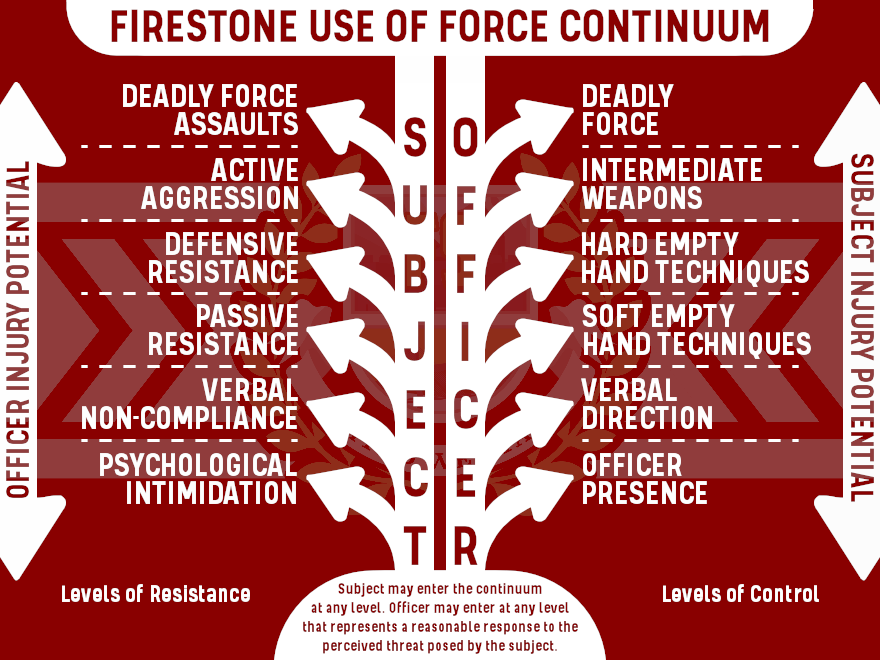PURPOSE
-
The purpose of this is to establish guidelines on reasonable uses of force within the State of Firestone in response to the perceived threat(s) posed by any subject.
-
Though some of these definitions don’t apply within a game setting, the general concept of each level of force does apply.
-
The State of Firestone encourages real definitions as we’re a community based on roleplay, and want to apply the proper definitions to the below for real-world exposure to the Use of Force Continuum.
State of Firestone uses the “Plus 1” rule, meaning you can only go 1 level of force above in which the Officer reasonably perceives the Subject is displaying.
DEFINITIONS
— Levels of Resistance —
Deadly Force Assaults
- Force used against an officer and/or another person that may result in death or great bodily
harm. It does not have to involve the use of a weapon if the officer reasonably believes that the force could cause death or great bodily harm.
Active Aggression
- Physical actions/assaults against an officer or another person with less than deadly force.
- Examples include: advancing toward, challenging, punching, kicking, grabbing, or wrestling with an officer or bystander.
Defensive Resistance
- Any action by a subject that attempts to prevent an officer from gaining control of the
subject, but is not an attack on the officer.
- Examples include: pulling/pushing away, resistance to handcuffing, fleeing, or attempting to defeat the “escort position”.
Passive Resistance
- Any resistance where a subject does not attempt to defeat an officer’s attempt to touch or
control, but will not voluntarily comply with verbal and physical attempts of control.
- Examples include: dead weight or no response to verbal commands.
Verbal Non-compliance
- Any verbal response indicating subject unwillingness to obey commands of detainment,
arrest or to stop unlawful or dangerous behavior.
- Examples could be a quiet statement such as “No, I will not put my hands behind my back,” and threatening verbal statements directed at the officer.
Psychological Intimidation
- Resistance that may or may not accompany verbal resistance.
- Examples include: attitude, appearance, physical readiness, blank stare, etc.
— Levels of Control —
Deadly Force
- Any use of force that creates a substantial risk of causing death or serious bodily injury.
Intermediate Weapons
- The application of any weapon that is not part of the human body to control resistance with
the intent to temporarily disable a subject but never with the intent to cause permanent injury.
- Examples include chemical agents, impact weapons, TASERs and emergency/improvised impact weapons. The use of such weapons is justified when lower forms of empty hand control will be insufficient.
Hard Empty Hand Techniques
- Techniques that have a probability of injury in the form of bruises, contusions, or
lacerations and designed to control active aggression. They can be used to control defensive resistance when lower forms of control have failed or when the officer “believes” lower forms of control will fail.
- An example is a defensive counterstrike (front kick, knee strike, angle kick, palm heel strike, and the brachial stun). All the techniques (except the front kick) target the large muscle mass and avoid joints, and vital organs that are close to the skin.
Soft Empty Hand Techniques
- Techniques with little or no potential for injury designed to control passive or defensive
resistance. They are used when verbal direction/commands are not effective and there is noncompliance with lawful orders.
- They include strength techniques, joint locks, pressure points or a light knee strike/distraction technique to the subject’s thigh. While these techniques may inflict pain to gain control, they generally will not cause any form of bruising or injury.
Verbal Direction
- The request or order made by an officer verbally to a subject.
Officer Presence
- The identification of a police officer’s authority, by the uniformed presence or the verbal
identification of being a police officer. In either case, an officer’s identification of their authority brings with it the assumption the public must obey a lawful order.
— Additional Definitions —
De-Escalation
- Taking action or communicating verbally or non-verbally during a potential force encounter in an attempt to stabilize the situation and reduce the immediacy of the threat so that more time, options, and resources can be called upon to resolve the situation without the use of force or with a reduction in the force necessary. De-escalation may include the use of such techniques as command presence, advisements, warnings, verbal persuasion, and tactical repositioning.
Less Lethal Force
- Any use of force other than that which is considered deadly force that involves physical effort to control, restrain, or overcome the resistance of another.
Saturation
- To introduce a chemical agent to an open air area or confined space which may cause irritation to skin, eyes, and respiratory discomfort.
Serious Bodily Injury (SBI)
- Injury that involves a substantial risk of death, protracted and obvious disfigurement, or
extended loss or impairment of the function of a body part or organ.
- FedoraMasterB98
State of Firestone Founder

